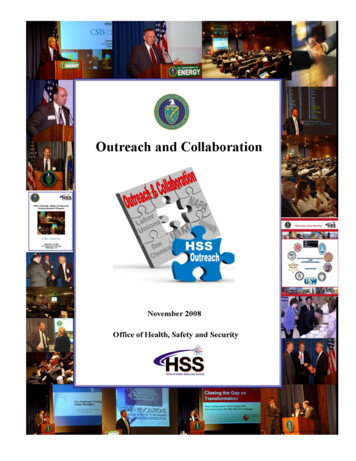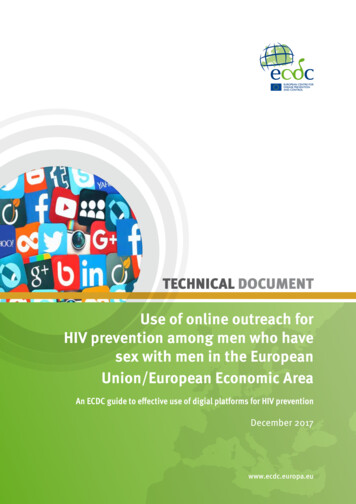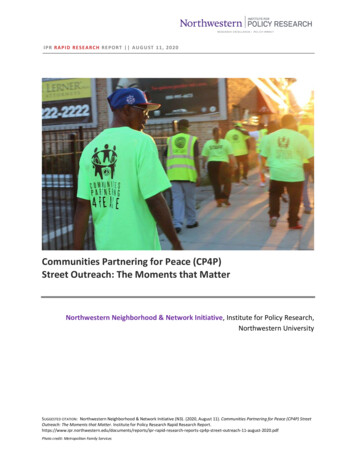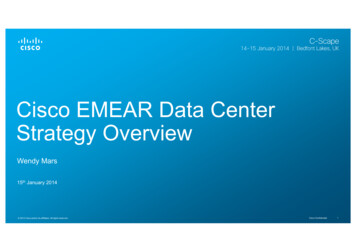
Transcription
Outreach and Collaboration At a glanceImportant Challenges Advance DOE collaborativecapabilities through newplatforms Create innovative solutions byusing collaboration tools togather input from all levels of anorganization, from the “shopfloor” to executive offices Create new interagencypartnershipsAccomplishments to Date Member of the National Academyof Public Administration’sCollaboration Project Entered into Fellowships withNational Defense University andthe Center for Strategic andInternational Studies Established Focus Group withlabor, program secretarial officers,and stakeholders Hosted visiting speakers fromnationally recognizedorganizations and industry Created a public website andfostered transparencyFuture Needs Line management fosteringand participating in crossorganizational collaboration Integrating collaborationand analysis activities toprovide a DOE-widecorporate learning functioni
Outreach and CollaborationIntroductionComing together is a beginning, staying together is progress, and workingtogether is success. . . . Henry FordThe Department of Energy (DOE) Office of Health, Safety and Security (HSS) has establishedan outreach and collaboration program to ensure continuous communications and informationsharing among its managers, stakeholders (including DOE line managers), and customers in theareas of health, safety, and security performance. Since its inception, HSS’s outreach andcollaboration efforts have enriched DOE through the following activities: HSS Focus Groups – Regular forums between labor unions, stakeholders, and HSSmanagers to focus on and address areas of concernVisiting Speaker Program – Engaging presentations from government and industryleaders on challenges facing the nation and potential solutionsCross-Organization Activities – Exploring and collaborating on ways to usetechnologies to facilitate collaboration and achieve organizational sustainabilityFellowship Programs – Maintaining a longstanding fellowship program with theNational Defense University and entering into a Fellowship with the Center forStrategic and International Studies to identify and resolve issues related to revitalizingand sustaining American scientific resourcesPublic Outreach Website – Establishing and maintaining an active website to provideaccess to HSS’s collaboration efforts.HSS has taken the initiative to expand its outreach and collaboration activities because of thecircumstances in which the Department finds itself. Emerging global trends forecast a period ofchallenges, including increased competition for a skilled technical workforce; higher energycosts; worldwide political instability; and continued terrorist activities. These challenges willaffect the nation in every aspect of daily life – from business, to industry, to education. DOEplays an important role in ensuring the security and vitality of the nation through its missions,which include energy and national security. Thus, DOE has numerous responsibilities, rangingfrom safeguarding national security assets to discovering cutting-edge scientific breakthroughs.HSS Focus GroupIn 2007, HSS created a Focus Group effort that integrates senior HSS managers from across theorganization with responsibilities for health, safety, environmental, and security matters tosolicit, discuss, and address topics and issues of common interest to them and their stakeholders.The HSS Focus Group provides a forum for responding to questions and concerns regarding HSSinitiatives and activities for continuing to improve health, safety, environmental, and securityperformance within the Department and maintaining an ongoing dialogue with managers andstakeholders to support these efforts and reinforce the safety culture within the Department. TheDepartment recognizes the vital role of workers as key to accomplishing the DOE mission at itssites and to ensure their safety in the performance of their activities.1
Outreach and CollaborationThrough meetings held in 2007, the HSS Focus Group identified potential opportunities forworking together and demonstrated the Department’s ongoing commitment to employee health,safety, and welfare. As first steps in this effort, HSS met with the following labor unions duringthis initial phase: Metal Trades Department, of the American Federation of Labor-Congress ofIndustrial Organizations Building and Construction Trades Department/The Center to Protect Workers Rights International Association of Bridge, Structural, Ornamental and Reinforcing IronWorkers International Association of Fire Fighters International Brotherhood of Electrical Workers International Guards Union of America and the Hanford Guards Union International Union of Operating Engineers Operative Plasterers’ and Cement Masons’ International Association of the UnitedStates and Canada Sheet Metal Workers International Association United Steel, Paper and Forestry, Rubber, Manufacturing, Energy, Allied Industrialand Service Workers International Union.The various labor unions were unanimous in their appreciation for HSS taking the initiative toorganize and open dialogue with them regarding their concerns and issues of interest.Another facet of the HSS Focus Group has been to meet with program secretarial officers(PSOs). These meetings included senior leadership from the Office of EnvironmentalManagement (EM), the Office of Science, the National Nuclear Security Administration(NNSA), and the Office of Civilian and Radioactive Waste Management. Meetings were alsoheld with the Government Accountability Project and the Health Physics Society. Like thosewith the labor unions, these discussions with the HSS Focus Group brought forth items ofinterest specific to the organizations. For example, the items of interest to EM included thatorganization’s safety commitments, improvement of its business operations, and the humancapital element of the organization. These discussions led EM and HSS to bolster nuclear safety,safety system oversight, design/engineering, and quality assurance technical expertise, providinga valuable and needed resource to the Department and, in turn, to EM. This example indicatesthe benefits of sharing perspectives on each organization’s efforts and working on common goalsthat support the entire DOE mission.The 2007 meetings and topics led to a better understanding of what concerned the unions, andthe 2008 agendas were set around high-priority topics. For example, in July 2008, the topic ofdiscussion was the Worker Safety and Health Rule, how it has been disseminated andimplemented, and its impacts on safer operations.HSS has met with and continues to communicate with the PSOs, labor unions, and otherstakeholders to maintain a direct interface and feedback between HSS managers and thoseresponsible for doing the work. The experience and insight gained helps HSS identify andrespond to issues and concerns and fosters opportunities for continued collaboration and2
Outreach and Collaborationintegrative work. In addition, HSS has gained perspectives from outside the organization on theinterests common to the entities – again, another aspect of outreach that both instructs andbenefits participants. For example, HSS now has a memorandum of understanding (MOU) withthe National Institute of Health Sciences regarding worker training opportunities. While HSSdoes offer extensive training through its National Training Center (NTC), there appear to beopportunities to utilize a cost-effective and appropriate vehicle for additional onsite training.Visiting Speaker ProgramJust as the HSS Focus Group forum brings together stakeholders and management personnel todiscuss topics of mutual interest, the HSS visiting speaker program draws together interestedparties to focus DOE’s attention to the emerging challenges and issues threatening nationalsecurity and economic prosperity. Implemented in 2008, the visiting speaker program creates avenue for presentations by leaders from diverse backgrounds, including business, organizationaltheory, management, and organizational sustainability and resilience. Speakers are selected andapproached based on their subject matter expertise, their own organization’s involvement withcollaborative efforts, and their business approach for developing sustainable organizations. As aresult, HSS not only seeks a wide variety of experts, but also brings diversified thinking to theattention of its management and personnel. The visiting speaker program audience is composedof DOE managers and staff, as well as managers from other Federal agencies, “think tank”organizations, professional societies, and businesses.For each presentation, HSS also indentifies and invites “Speaker Sponsors” who represent bothDOE-wide and external involvement in the visiting speaker program. The Speaker Sponsors aresenior managers who engage the audience, demonstrate their organizations’ interests in the topicbeing presented, and stress the need for collaboration across organizations. Recent SpeakerSponsors have included James Rispoli, Assistant Secretary of Energy for EM; WilliamOstendorff, Principal Deputy Administrator of the NNSA; and Robert Boege of the Alliance forScientific and Technology Research in America. In his sponsorship remarks, Assistant SecretaryRispoli indicated that without a strong management commitment to address sustainability issues,there would be a high risk that the quality of work products and quality of services could not besustained and, in fact, would decline. Mr. Rispoli further emphasized that what DOE doesdirectly contributes to the health of the nation.The speakers and the presentations topics in the 2008 HSS visiting speaker program include: Jonathan Breul, Executive Director of the IBM Center for the Business ofGovernment. Mr. Breul’s presentation was on the business model of sustainabilityand how the government and public-sector organizations could benefit by adoptingsustainability into their operations. The IBM Center for the Business of Governmentconnects public management research with applications and helps public sectorexecutives improve the effectiveness of government. Mr. Breul’s presentationidentified and addressed some of the most challenging areas for public sectormanagers. Frank DiGiammarino, Vice President for Strategic Initiatives at the NationalAcademy of Public Administration (NAPA). Mr. DiGiammarino’s presentation was3
Outreach and Collaborationon the NAPA Collaboration Project and the need for collaboration to transformorganizations and drive innovation. NAPA is a non-profit, independent coalition of600 distinguished public management and organizational leaders who tackle thenation’s most critical and complex challenges. Mr. DiGiammarino’s presentationexamined the need to move beyond “reactive change” toward a “proactive andincremental” change, and further discussed collaborative technologies that can enabletransformational change. Erik Peterson, Senior Vice President and Director of the Global Strategy Institute ofthe Center for Strategic and International Studies (CSIS). A bipartisan, non-profitorganization, CSIS conducts research and analysis, develops policy initiatives thatlook into the future and anticipate change, and provides strategic insights and policysolutions to decision-makers in the public and private sectors. Mr. Peterson’spresentation was on the seven forces or circumstances (population, resourcemanagement, technology, knowledge, economic integration, conflict, andgovernance) that are changing the global landscape today and for decades to come. Jeff Erickson, Vice President of Client Services for SustainAbility, a strategicconsulting firm and independent “think tank” that works with businesses to identifyand manage key environmental, social, and economic risks and opportunities and todevelop innovative solutions to protect and create future value. SustainAbility worksextensively in the chemical and energy industries – industries with direct relevance toDOE. Mr. Erikson’s presentation was on the business and industrial models ofsustainability and the impact of sustainability on organizations, as well as thecompatibility of this model with public-sector missions. Dr. Susan Butts, Senior Director of External Science and Technology Programs atDow Chemical Company. Dr. Butts’s presentation was on the chemical industry’schallenges and Dow Chemical’s experience utilizing the business model ofsustainability. Dr. Butts is responsible for Dow’s contract research activities withU.S. and European government agencies and sponsored research programs at over100 universities, institutes, and national laboratories worldwide. Christopher A. Hart, Deputy Director for Air Traffic Safety Oversight at the FederalAviation Administration (FAA). Mr. Hart’s organization provides data, analyticaltools and processes, safety risk assessments, and other assistance to support numerousFAA and worldwide aviation community safety programs. His organization alsospearheads industry-wide safety activities, such as the Global Aviation InformationNetwork, and helps identify key safety issues and emerging trends affecting aviationsafety. Mr. Hart’s presentation was on Highly Reliable Organizations (HROs) andhow the characteristics of HROs directly correlate to DOE’s mission and measuringmission success. In this message, it was clear that health, safety, and security areintegral to reliable mission performance.4
Outreach and CollaborationPlans for the visiting speaker program in 2009 include a panel of industry, academia, research,labor, and Federal agencies to discuss status and needs in order to keep the U.S. industrial basestrong.Cross-Organizational InitiativesAs a result of the presentation by Mr. DiGiammarino on the use of collaborative technologies,HSS now participates in NAPA’s collaboration project. HSS sees this as a tool to improve itsservices and allow stakeholders to engage more effectively on performance issues relating tohealth, safety, and security. By utilizing NAPA’s expertise and experience, HSS will be able tolearn from NAPA’s experiences and contacts with other Federal agencies in the use oftechnology to facilitate and foster collaboration. This effort will also enable HSS to work withother Federal agencies in a trusted virtual collaborative working space.Another collaborative effort by HSS is the sustainability program. After a review of industrialsustainability programs, HSS learned that industries organize their sustainability efforts intovarious distinct elements, allowing them to categorize operational data, analyze trends, andassess overall performance. Accordingly, HSS conducted research, which considered 15 yearsof experience in the private sector and the many national initiatives set forth by the U.S.government in the past decade, that culminated in the development of a sustainability modelmade up of 12 elements:1)2)3)4)5)6)InfrastructureHuman CapitalAcquisition, Procurement, and SupplyManagementSecurityLegal and LicensingEnvironmental Stewardship7)8)9)10)11)12)SafetyMission and MarketsBusiness SystemsLeadership and Organizational TransformationStewardship, Good Governance, and ReputationScience, Technology, and InnovationHSS is collaborating with its national laboratories to test and refine the sustainability model forapplicability across the DOE complex. The national laboratory system was chosen for the pilotstudy because they are the last nationally-supported bastions of basic science and research anddevelopment, and they provide key scientific infrastructure under their “user facility model.”Moreover, the economic and national security strength of the U.S. has always been dependentupon U.S. technological superiority.Fellowship ProgramsHSS has a longstanding fellowship program with the National Defense University (NDU). Notonly has HSS provided personnel to participate at the Industrial College of the Armed Forces andthe National War College, but HSS has also worked with NDU to activate and staff the DOEChair at NDU to work with NDU officials on curricula and engage in national securitydiscussions and activities.In 2008, through HSS, DOE entered into a Fellowship with the CSIS’s Global Strategy Institute(GSI) to identify and resolve issues related to revitalizing and sustaining American scientificresources, encouraging the next generation of scientists and engineers, and addressing economicand national security threats. Through this Fellowship, DOE, HSS, and CSIS discovered areas of5
Outreach and Collaborationcommonality between the GSI and the DOE’s strategic missions and the efficacy of bringingtogether representatives from the two organizations to work toward resolving critical nationalissues.HSS Collaboration ActivitiesHSS collaborates both within DOE and externally to solve issues and challenges to theorganization, as well as meeting its strategic mission. These efforts include working with manyFederal agencies in various topics relating to the health, safety, and security of the public, theworkforce, and environment.TrainingThe scope of DOE’s training programs requires the maintenance and regular renewal of bothinternal and external constituents, collaborative partners, and program participants. Examples ofthese include: Trade Unions. HSS proactively champions improved training programs designed toreduce inconsistencies, redundancies, and gaps among Federal and contractortraining. The Energy Facility Contractors Group (EFCOG). HSS is a key sponsor of EFCOG’shealth-, safety- and security-oriented working groups. Universities. DOE collaborates with the University of Maryland and EFCOG inconducting a human capital profiling study designed to assess the reliability andsustainability of the Department’s current and future workforce. Department of Labor (DOL)/Occupational Safety and Health Administration. Underthe terms of a 1992 MOU, DOE and DOL collaborate on mutually beneficialoccupational safety and health training programs. National Institutes of Health/National Institute of Environmental Health Sciences(NIEHS). An agreement between HSS and NIEHS is being established forcollaboration and sharing of information and expertise to help streamline trainingacross DOE. DOE Corporate Operating Experience Program. The program analyzes a broad rangeof incident reports, site performance and trending information, and a range of otherlessons learned and best practice information applicable to DOE operations. Other Agencies’ Security Classification Programs. HSS has implemented anextensive outreach program to other governmental agencies, including theDepartments of Defense, Homeland Security, and State, that provides informationand training regarding the classification and declassification of Restricted Data (RD)and Formerly Restricted Data (FRD). The Performance Testing and Analysis Center (PTAC). PTAC serves as theDepartmental resource for implementing innovative and cost-effective protectionstrategies by fostering collaboration between field and Headquarters securityprofessionals.6
Outreach and Collaboration Oak Ridge Institute for Science and Education Radiation Emergency AssistanceCenter/Training Site. HSS provides physician training health physics and radiationemergencies. The Institute of Nuclear Power Operations (INPO). HSS and INPO have a contractthat provides DOE Federal and contractor employees access to certain INPO productsand services. NTC Users and Safety Program Collaborators. The NTC collaborates with manyinternal and external organizations in its ongoing effort to enhance and standardizetraining.Oversight and EnforcementAt the highest level, HSS’s collaborative partners in managing and implementing DOE’sindependent oversight and enforcement programs include all DOE program offices, operatingoffices, and field organizations spread throughout the entire nation. The spirit of thiscollaboration is well expressed in the DOE Safety Oversight Manual, which notes that “Themanual is intended to be used in an integrated and collaborative manner so that DOE linemanagement safety oversight is developed and implemented by using relevant safety informationfrom all material sources, including contractors, sites, line management, DOE Headquarters,independent oversight, and external oversight.”Although its regulatory mission is distinct from DOE’s, the Nuclear Regulatory Commission(NRC) is a natural collaborative partner with HSS in its oversight of nuclear facility and nuclearworker safety. Moreover, through an MOU signed in July 2007, DOE and NRC have expandedtheir partnership and cooperation for implementing the Global Nuclear Energy Partnership(GNEP). Through this enhanced cooperation, DOE will share the latest information on advancedrecycling technologies with the NRC, enabling the Commission to develop license, regulatory,and oversight criteria for GNEP facilities, some of which may be located on DOE sites.The Office of Independent Oversight is a partner in two standing committees within theDepartment: the Cyber Security Working Group, which consists of members from IndependentOversight’s Office of Cyber Security Evaluations, the Office of the Chief Information Officer(OCIO), and key cyber security managers from Headquarters program offices; and the ExecutiveSteering Committee, which consists of the Chief Information Officer, the Chief Health, Safetyand Security Officer, and the DOE and NNSA Undersecretaries. The Office of IndependentOversight also has an ongoing relationship with management and staff from the NuclearCommand and Control System (NCCS) support staff. NCCS personnel periodically participate inIndependent Oversight safeguards and security inspections to evaluate the inspection process andprovide feedback on program effectiveness.Policy and AssistanceHSS collaborates within DOE and with external entities to develop Departmental health, safety,and security policies and directives; promote implementation; evaluate effectiveness; updateguidance when necessary; and prioritize issues based on feedback from line management, policy7
Outreach and Collaborationpanels, and independent oversight activities. A key result of this collaboration is increasinglyeffective integration of policy and assistance efforts relating to health, safety, and security.HSS represents the Department’s interests on interagency committees addressing issues relatingto nuclear safety, the environment, and quality assurance. Collaborating partners include theEnvironmental Protection Agency, the Department of Homeland Security, the American NuclearSociety, and the American Society of Mechanical Engineers. This responsibility also extends tocoordination with national and international standards organizations. Benefits of this activityinclude better Federal regulations, consistent interagency guidance on technical procedures, andmore effective use of resources.Worker Health and SafetyIn establishing and implementing worker health and safety policies and programs, HSS has manyconstituents and collaborative partners. Under the provisions of 10 CFR 851, DOE complieswith applicable OSHA and other consensus standards/policies, such as those of the National FireProtection Association, the American Conference of Governmental Industrial Hygienists, andnumerous American National Standards Institute (ANSI) standards. In meeting itsresponsibilities for developing and maintaining DOE worker health and safety policies andprograms, HSS also interacts with many other internal and external entities, programs, andconstituents in order to keep current regarding new information and technologies and to facilitateadjustments to requirements and expectations. Examples of these collaborative partners include:Department of Health and Human Services/National Institute for Occupational Safety andHealth; NIEHS; international partners (Russian Ministry of Health, International Consortium forApplied Radiation Research, Japanese Ministry of Health, Labor and Welfare); hospitals anduniversities; and trade unions.SecurityThe constituents for HSS security activities are individuals and organizations that have a need toaccess DOE facilities, personnel, and information. To improve the personnel clearanceinvestigation and adjudication processes, HSS is collaborating with Office of the Director ofNational Intelligence, the Department of Defense (DoD), the Office of Personnel Management,the Office of the Assistant to the President for National Security Affairs, and the Office ofManagement and Budget to modernize and streamline government-wide security and suitabilityprocesses. For cyber security, HSS is a partner in two standing committees within theDepartment: the Cyber Security Working Group, which consists of members from IndependentOversight’s Office of Cyber Security Evaluations, the OCIO, and key cyber security managersfrom Headquarters program offices; and the Executive Steering Committee, which consists ofthe Chief Information Officer, the Chief Health, Safety and Security Officer, and the DOE andNNSA Undersecretaries.Technology Deployment and Nuclear Information and Weapons DataTo facilitate collaboration within DOE and with other Federal agencies, HSS developed aninnovative approach to acquisition – the “joint acquisition process.” A memorandum ofagreement is established and maintained for each technology deployment site. HSS covers theprocurement, testing, evaluation, and training costs associated with the technology, while the site8
Outreach and Collaborationaccepts responsibility for implementation, operation, and maintenance. In addition, HSS and sitepersonnel cooperatively evaluate and document safety, performance, and other lessons learnedduring the process and transfer that data to the Security Technology Information Archive for useby other DOE parties, as well as DoD and the NRC. HSS’s collaborative experience with otherDOE offices and Federal agencies indicate that its partners greatly value technology deploymentefforts; NNSA leadership has stated that technology deployment is a big success in terms ofproviding benefits to multiple agencies, dedicated facilities and personnel to conduct field tests,and cost savings through cost sharing and cost avoidance.Because HSS holds the responsibility for classification and maintains unique subject matterexpertise in nuclear information, it has a large client base in the Federal government andprovides continuous assistance to these agencies in the implementation of classification programrequirements through extensive outreach in the handling of RD, FRD, and UnclassifiedControlled Nuclear Information. This outreach program consists of assistance visits, training,and quality assurance reviews. HSS also maintains an outreach hotline for issues concerning RDand FRD.Public Outreach ProgramHSS created and maintains an extensive website (http://hssoutreach.energy.gov), available to thegeneral public, to inform stakeholders, citizens, Congress, industry, and professional societiesabout HSS and its activities. The website functions as a subject-matter clearinghouse withinformation on diverse areas such as worker safety and health, policy, training, and security. TheOutreach and Collaborating Partners portion of the website offers a valuable resource. There arelinks to the Focus Group efforts, with reference material and information on upcomingdiscussions and participants. The HSS visiting speaker program is also listed with the calendarof events and reference material, including presentation documents, background of theparticipants, and highlights from the presentations. Also included on this site is the latestinformation and updates on HSS efforts regarding sustainability, including the sustainability pilotstudy.Providing this information enhances governmental transparency to concerned citizens andprovides an example of the leadership necessary to transform an organization. HSS believes thatoutreach and collaboration, together with analysis, are learning functions of an organization.HSS has renewed these activities in both method and scope and with participation at all levels ofDOE leadership.9
Outreach and Collaboration 4 on the NAPA Collaboration Project and the need for collaboration to transform organizations and drive innovation. NAPA is a non-profit, independent coalition of 600 distinguished public management and organizational leaders who tackle the nation's most critical and complex challenges. Mr.










